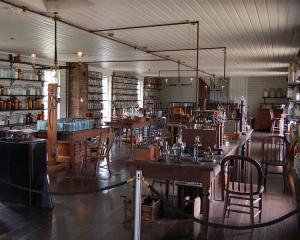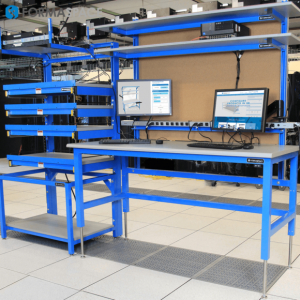The Time Has Come for Science Parks Again
What’s behind the resurgence in the science parks? Read more about the history of science parks and why they could be the future of work.
The second new science park development is taking place in Philadelphia, within the University Park zone, which is becoming the heart of healthcare, life sciences, and biotech industries.”
AUSTIN, TEXAS, UNITED STATES, December 19, 2022 /EINPresswire.com/ -- The commercial office market has been dealt a heavy blow in 2020 due to the coronavirus pandemic.— Formaspace
But recent breakthroughs in health science research, such as the long-anticipated coronavirus vaccine from Pfizer BioNTech, are generating renewed interest in science real estate projects on the part of commercial property developers.
Two recently greenlit projects exemplify this emerging science park construction trend.
The first project is a new life science hub on the west side of Manhattan. Taconic Partners has engaged the architecture firm Perkins & Will to design the new facility on the site of a former auto showroom. When completed in early 2023, the new building will become part of an emerging life science cluster on Manhattan’s West Side.
The second new science park development is taking place in Philadelphia, within the University Park redevelopment zone (located west of the Schuylkill River near Drexel University and the University of Pennsylvania), which is becoming the heart of Philly’s healthcare, life sciences, and biotech industries. The new 250,000 ft.² eight-story building, designed by The Sheward Partnership, will feature advanced sustainability and energy efficiency features allowing it to achieve LEED and WELL v2 platinum certifications.
These two new projects are breathing life into what has been a disappointingly moribund commercial property development market up and down the East Coast.
Hopefully, it signals a new positive economic trend that coincides with the dawn of the New Year and the promise of the widespread coronavirus vaccine program that will allow people to once again return to work.
But these new developments have also piqued our curiosity about science parks and how they came to be. It turns out they have a long and interesting history that’s closely aligned with some of the major developments in American health science, consumer goods manufacturing, military and aerospace applications, and more.
The Age Of Discovery And The Development Of The Modern Science Park
When we think of Tesla and Menlo Park today, we think of Silicon Valley in California, where Elon Musk makes Tesla cars, and Menlo Park is the home of SRI International, the famed research institute founded by Stanford University.
But if we turn the clock back to the late 19th century and asked someone about Menlo Park or Tesla, we would get quite a different answer. In those days, Thomas Alva Edison was known as The Wizard of Menlo Park *– after the location of the famous New Jersey laboratory he built in 1876 and where he subsequently invented the phonograph and the incandescent light, just two of his over 1,000 patented inventions.
(*Confusingly, Menlo Park in California was founded first, and Menlo Park in New Jersey was named after it.)
Groundbreaking Science Park Pioneer: Thomas Edison’s Menlo Park Laboratory
It’s hard to overstate the importance of Thomas Edison’s pioneering Menlo Park research facility, yet in many ways, his scientific discoveries and technical research projects were matched by those of his close friends Henry Ford (inventor of the Ford Model T and founder of the Ford Motor Company), Harvey Firestone (the rubber tire company magnate).
The three friends, (who called themselves the vagabonds) not only collaborated on research projects they also vacationed together in Florida every winter.
Firestone, who founded his company in Akron, Ohio (already home to three other leading tire manufacturers, including B.F. Goodrich and Goodyear), made tires for Ford cars. Ford, whose industrial discoveries include the introduction of the moving assembly line and the use of high tech materials, such as vanadium steel, pursued many other areas of technology as well, including developing tractors, building airplanes (the famous Ford TriMotor), and developing artificial rubber at the Edison Botanic Research Corp. in Fort Myers, Florida.
In his later years, Edison’s company General Electric would vigorously compete with George Westinghouse (who got his start inventing air brakes on trains) for supremacy in setting the standards for the nascent electrical grid; Edison initially promoted DC current, while Westinghouse created a more practical AC-based power grids suitable for more efficient long-distance electric transmission.
Here is where Tesla comes into the picture – not Elon Musk, but the original Tesla, Nikola Tesla, the Serbian immigrant electrical engineering genius. Tesla licensed his alternating current (AC) induction motor to Westinghouse and later advised him how to build a successful two-phase AC generating system at Niagara Falls. Westinghouse bought Tesla’s patents, including the design for a unique induction motor system (used today in Tesla cars). Sadly, Tesla’s own laboratory in Manhattan was destroyed by fire.
Key Research Facilities In The Development Of Airplanes And Aeronautics
Over 100 years later, General Electric would also be known for manufacturing jet engines, but we’re getting ahead of ourselves.
Another key step in the history of science parks takes place in Dayton, Ohio, where the Wright brothers built the first successful self-powered aircraft, which first flew on the windy dunes at Kitty Hawk, North Carolina. Thanks to Henry Ford’s penchant for preserving history, we can see the original Wright Brothers building, which Ford had transported to Greenfield Village in Michigan.
Thanks to the Wright Brothers’ invention, the Dayton area became an important hub for airplane and aeronautics research.
Alexander Graham Bell, the inventor of the telephone, also had a strong interest in aviation. One of the first people Bell hired for his Aerial Experiment Association (AEA) was Glenn Curtiss, who later helped standardize training for US Naval aviation in Dayton. His subsequent venture, the Curtiss Aeroplane Company, grew rapidly during the war to become the world’s largest aircraft manufacturer – and a bitter rival to the Wright brothers. And today, the fields of Huffman Prairie where the Wright Brothers tested their Wright Flyer III is the site of Wright-Patterson Air Force Base, one of the military’s leading logistics operations centers and aerospace research facilities.
Trailblazing Aviation Research Facility: The Wright Bros. Bicycle Shop And Dayton’s National Aviation Heritage Area
Research And Development Of New Household Consumer Products
The 1920s and 1930s saw a rapid rise in packaged consumer goods, from fully prepared cereals (from the Post Company and Kellogg’s of Battle Creek, Michigan) to soaps, washing powders, and toothpaste from Cincinnati-based Procter & Gamble. Researchers at Kodak’s facility in Rochester, New York, also played a central role in documenting American life through their popular line of Brownie cameras. Polaroid, founded in 1937, was another innovation juggernaut, called the “Apple Computer” of its day. Other important research centers, such as the Battelle Memorial Institute, founded in Columbus, Ohio in 1926 (probably the largest research company you’ve never heard of), offered some of the first “contract for hire” research services in the world. (More about Battelle later.)
Read more...
Julia Solodovnikova
Formaspace
+1 800-251-1505
email us here



